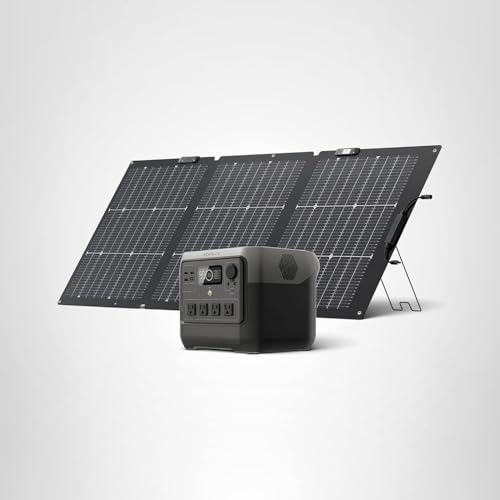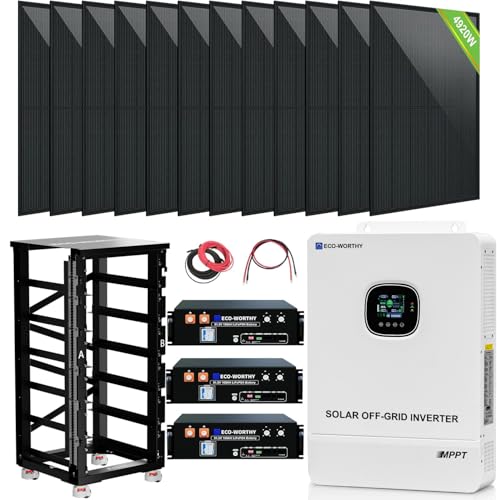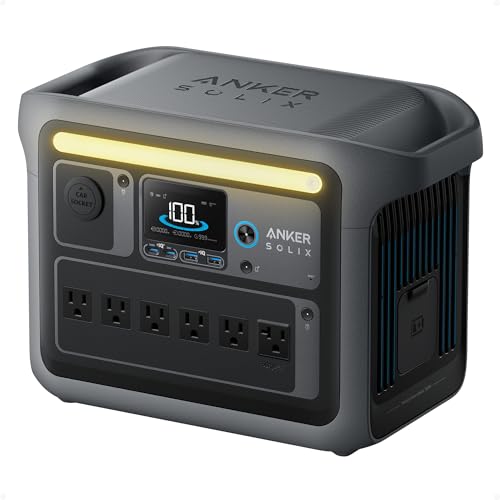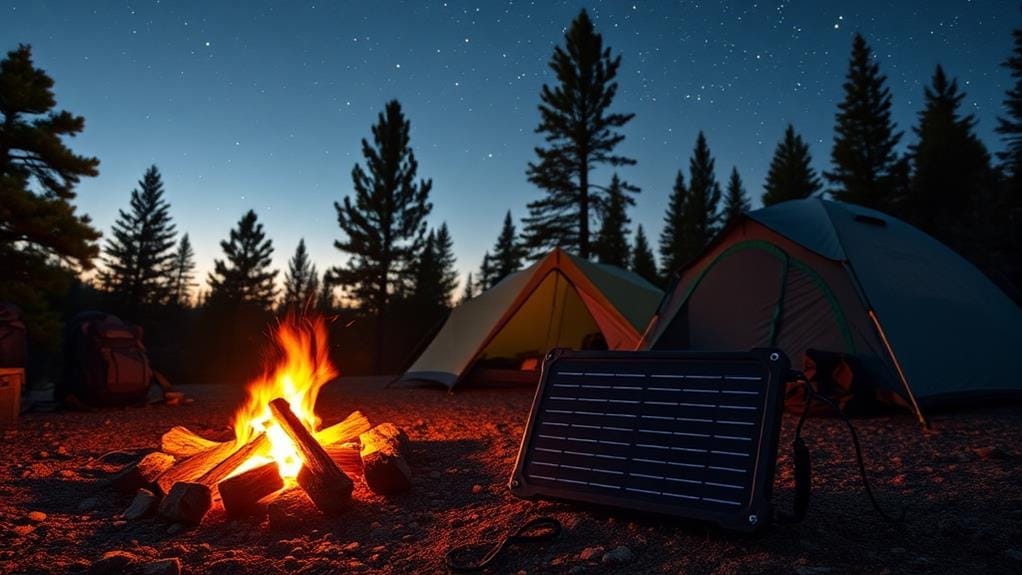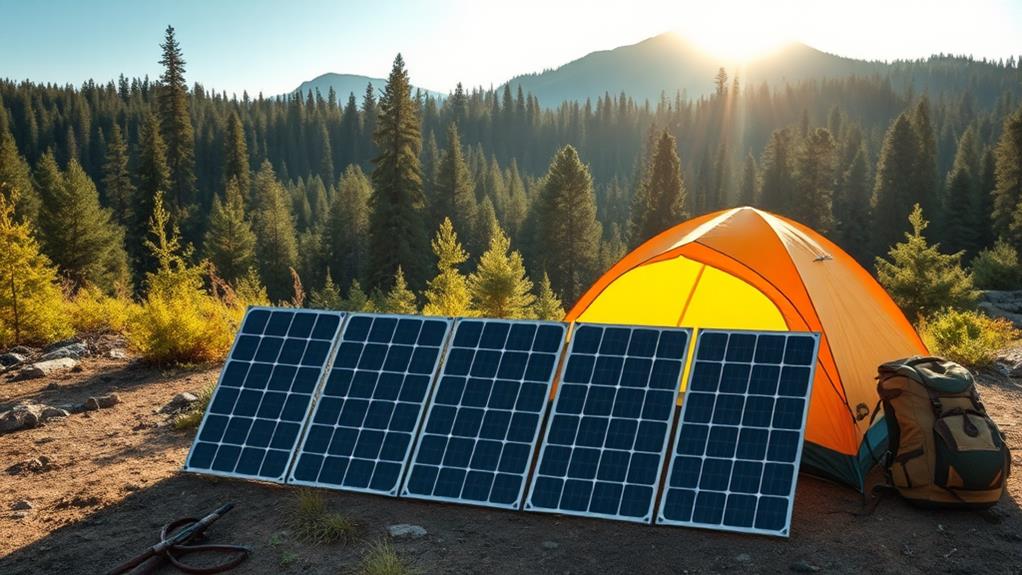In 2025, top-tier solar energy backup systems offer unparalleled off-grid power solutions for your home. The EF ECOFLOW DELTA Max (2000) and RIVER 2 Max provide high-capacity LiFePO4 batteries with rapid charging capabilities. For larger setups, the ECO-WORTHY 10KW kit delivers extensive off-grid power. The Anker SOLIX C1000 and Goal Zero Yeti PRO 4000 offer portable options with impressive output. These systems feature advanced charging options, including solar, AC, and car outlets, ensuring versatility. When selecting a system, consider power capacity, battery lifespan, charging speed, portability, and expandability. Evaluating these factors will guide you towards the ideal solar backup solution for your specific needs.
Key Takeaways
- EF ECOFLOW DELTA Max offers 2016Wh capacity, powering up to 15 devices with 3400W output and multiple charging options.
- ECO-WORTHY 10KW Home Off-Grid System provides high-capacity power with a 10KW inverter and twelve 410W solar panels.
- Goal Zero Yeti PRO 4000 features a 4000Wh LiFePO4 battery with 3600W continuous output for extended off-grid use.
- Anker SOLIX C1000 combines 1056Wh capacity with rapid 80% charging in 43 minutes for quick power restoration.
- LiFePO4 batteries, used in top systems, offer over 3,000 cycles and a 10-year lifespan for long-term off-grid reliability.


![[Ultra] ECO-WORTHY 1200W 24V 5.52KWH Lithium Battery Solar System Off Grid:6pcs 195W Bifacial Solar Panels+2Pcs 12.8V 280Ah Lithium Battery+60A MPPT Charge Controller+3000W Pure Sine Wave Inverter](https://m.media-amazon.com/images/I/810MkJzpl4L._SS520_.jpg)



EF ECOFLOW Solar Generator DELTA Max (2000) with 160W Solar Panel
- Endless Solar Power. EcoFlow DELTA Max(2000) MPPT Controller guarantees full recharge with 160W solar panels with zero pollution emission. Use it as a...
- Power Pretty Much Anything. 2400W output to power up to 15 devices at once. Power 3400W appliances with X-Boost on. That means during a power outage...
- Waterproof & Durable. EcoFlow 160W solar panel is waterproof to endure all weather conditions, ideal for outdoor activities such as camping, climbing,...
Last update on 2025-12-24 / Affiliate links / Images from Amazon Product Advertising API
If you’re in the market for a robust solar backup system that can power multiple devices simultaneously, the EF ECOFLOW Solar Generator DELTA Max (2000) with 160W Solar Panel is worth considering. This system boasts a 2016Wh capacity and can power up to 15 devices concurrently, including appliances up to 3400W with X-Boost. The MPPT controller enables full recharge using the included 160W solar panel, promoting renewable energy use.
You’ll appreciate the multiple charging options, including AC, solar, car, and EcoFlow Dual Fuel Generator. The unit can fully charge in 1.8 hours via wall outlets, and you can combine AC with Smart Generator for faster charging. The EcoFlow App allows remote monitoring and control, enabling customization of power usage. However, be aware that charging efficiency decreases in temperatures over 100°F, with ideal performance around 88°F. At nearly 50 pounds, consider using a hand truck for transport.
Best For: The EF ECOFLOW Solar Generator DELTA Max (2000) is best for homeowners seeking a reliable backup power solution for emergencies, outdoor enthusiasts requiring portable power for camping or RV trips, and those interested in utilizing renewable energy for their power needs.
Pros:
- High capacity (2016Wh) with ability to power up to 15 devices simultaneously
- Multiple charging options including solar, AC, and car charging
- Smart features with remote control and monitoring via EcoFlow App
Cons:
- Heavy weight (nearly 50 pounds) may limit portability
- Some users report discrepancies in wattage readings and unexpected power draw
- Charging efficiency decreases in high temperatures (over 100°F)
EF ECOFLOW RIVER 2 Max Solar Generator with 160W Solar Panel
- [Charge Anywhere] Replace your outdoor generator with clean, renewable energy. Recharge RIVER 2 Max with this lightweight, portable solar panel...
- [Power 80% of Home Appliances] With an output of up to 1000W, run 11 devices at the same time without overloading.
- [Runs for Years] LiFePO4 battery technology provides RIVER 2 Max with 3000+ charging cycles, so you can keep powering devices for almost 10 years. LFP...
Last update on 2025-12-23 / Affiliate links / Images from Amazon Product Advertising API
Anyone seeking a powerful, fast-charging solar generator for home backup or outdoor adventures will find the EF ECOFLOW RIVER 2 Max with 160W Solar Panel an excellent choice. This 512Wh LiFePO4 portable power station boasts impressive specifications, including a 60-minute full charge time and 3000+ charging cycles, ensuring a battery lifespan of nearly 10 years. With up to 1000W output and the ability to power 11 devices simultaneously, it’s versatile enough for various applications. The system’s compact design, weighing under 15 pounds, makes it ideal for both home use and outdoor activities.
The RIVER 2 Max offers multiple charging options, including solar (4 hours), AC outlet (60 minutes), car outlet, and USB-C. Its integrated power adapter enables efficient 600W/hour charging, while its multi-device compatibility supports AC, DC, USB-A, USB-C, and 12V ports. Users report successful operation during power outages and outdoor excursions, powering essential appliances, lights, and fans.
Best For: Outdoor enthusiasts, emergency preparedness advocates, and homeowners seeking a reliable, fast-charging portable power solution for various applications.
Pros:
- Incredibly fast charging time of 60 minutes for full capacity
- Versatile with multiple charging options and device compatibility
- Lightweight and portable design for easy transport and storage
Cons:
- Some users report Wi-Fi connectivity issues with the companion app
- Higher initial cost compared to some competing products
- Limited capacity for powering high-wattage appliances for extended periods
EF ECOFLOW Solar Generator River 2 Pro with 160W Portable Solar Panel
- [Charge Anywhere With Solar Energy] Replace your outdoor generator with clean, renewable energy. Recharge RIVER 2 Pro with this lightweight, portable...
- [Power 80% Of Your Appliances] With an output power of up to 1600W, run 80% of all your appliances, even high wattage ones. With 11 outlets, from 800W...
- [Long-lasting LFP Battery and Solar Panel] Using LiFePO4 battery cells, use and recharge RIVER 2 Pro more than 3000 times before hitting 80%. That’s...
Last update on 2025-12-24 / Affiliate links / Images from Amazon Product Advertising API
The EF ECOFLOW Solar Generator River 2 Pro with its 160W Portable Solar Panel is a powerhouse for off-grid enthusiasts and emergency preparedness advocates. This 768Wh portable power station boasts impressive recharge times, taking only 70 minutes via AC outlet or 4.8 hours with the included solar panel. With a 1600W output capacity and 11 outlets, you’ll power 80% of appliances effortlessly. The LiFePO4 battery cells guarantee longevity, offering over 3000 recharge cycles before reaching 80% capacity. The IP68-rated solar panel, protected by ETFE film, withstands harsh conditions. At 17.2 lb, it’s compact yet robust, ideal for outdoor adventures or home backup. The EcoFlow app provides real-time monitoring and control, while the advanced BMS safeguards against voltage, current, and temperature fluctuations, ensuring peak performance and safety.
Best For: Outdoor enthusiasts, campers, and homeowners seeking a reliable, portable power solution for off-grid adventures or emergency backup during outages.
Pros:
- Fast charging capabilities with multiple recharge options
- High output power and versatile port selection
- Durable design with long-lasting LiFePO4 battery and waterproof solar panel
Cons:
- Relatively high price point compared to some competitors
- May not be sufficient for powering high-wattage appliances for extended periods
- Limited power draw reporting for low wattage devices
ECO-WORTHY 10KW Home Off-Grid Solar Power System Kit
- [Efficient and Powerful Solar Inverter] Rater output 10KW and 20KW peak power,support single-phase and split-phase output in one device....
- [410W High Power Solar Panel] 410W Mono-crystalline Solar Panel (Black). Low power loss in cell connection compared to conventional modules. Improved...
- [Seamless Compatibility, Plug-and-Play] ECO-WORTHY 48V(51.2V)Server Rack Battery is rigorously tested and certified to UL1973 & UL9540A standards, the...
Last update on 2025-12-24 / Affiliate links / Images from Amazon Product Advertising API
Homeowners seeking a holistic off-grid solar solution will find the ECO-WORTHY 10KW Home Off-Grid Solar Power System Kit an attractive option. This all-inclusive package includes a 10KW solar hybrid inverter, three 48V 100Ah LiFePO4 batteries, and twelve 410W mono-crystalline solar panels. The system boasts a 10KW output with a 20KW peak power capacity, supporting both single-phase and split-phase output configurations. You’ll benefit from the solar panels’ low power loss, improved shading tolerance, and heat-strengthened glass, backed by a 25-year warranty. The system’s expandability is significant, with the potential to add up to 11,000W of solar panels and double the battery capacity. While the plug-and-play setup guarantees easy installation, be mindful of high return shipping costs. This kit is ideal for those with technical knowledge, seeking a robust off-grid power solution.
Best For: Homeowners with technical knowledge seeking a comprehensive, expandable off-grid solar power solution for their residence.
Pros:
- Complete kit includes all necessary components for a 10KW off-grid solar system
- Highly expandable, allowing for additional solar panels and battery capacity
- High-quality components with long warranties and efficient performance
Cons:
- Large size of solar panels requires pallet shipping, potentially increasing costs
- High return shipping costs if dissatisfied with the product
- May require technical expertise for optimal setup and maintenance
Anker SOLIX C1000 Portable Power Station (1056Wh)
- Charge Up in a Flash: Achieve 80% battery capacity in just 43 minutes with the Anker SOLIX C1000's UltraFast recharging technology (operating...
- A Decade of Power: Trust in a decade-long journey with the Anker SOLIX C1000 Portable Power Station, featuring exceptional battery longevity with its...
- Powerhouse Versatility: The Anker SOLIX C1000's SurgePad technology delivers a massive 2400W output, enabling 99% of appliances to be powered through...
Last update on 2025-12-24 / Affiliate links / Images from Amazon Product Advertising API
Power-hungry homeowners seeking a reliable backup solution will find the Anker SOLIX C1000 Portable Power Station a game-changer. This compact powerhouse boasts an impressive 1800W output capacity with a 2400W peak, driven by a 1056Wh LiFePO4 battery. You’ll appreciate its rapid charging capabilities, reaching 80% capacity in just 43 minutes and full charge in under an hour. The C1000’s SurgePad technology guarantees compatibility with 99% of appliances through 11 versatile ports, while its 600W fast solar recharging option fully replenishes the battery in 1.8 hours.
The Anker app provides real-time monitoring and customizable charging speeds, enhancing your control over power management. With a 3,000-cycle lifespan and 15% smaller footprint than comparable units, the C1000 offers longevity and portability. Users report excellent performance during outages, powering essential devices for up to 24 hours. The optional expansion battery further extends capacity, making it ideal for extended outdoor use or prolonged power disruptions.
Best For: Homeowners and outdoor enthusiasts seeking a reliable, high-capacity portable power solution for emergencies, camping, or off-grid living.
Pros:
- Rapid charging capabilities with 80% charge in 43 minutes
- Versatile compatibility with 99% of appliances through 11 ports
- Long lifespan with 3,000 battery cycles over 10 years
Cons:
- Higher price point compared to some competitors
- Occasional quirks with expansion battery charging and UPS mode
- App features for power usage tracking could be more comprehensive
Goal Zero Yeti PRO 4000 Portable Power Station (6th Gen)
- Best in Class Power Output: The Yeti PRO 4000 includes next-gen efficient inverter technology that lets you power more for longer. It has 80% more...
- Class-Leading Lifespan: Upgraded Lithium Iron Phosphate battery (LFP) technology provides an incredible 4000+ cycles, and up to 10 years of daily use;...
- Exceptional Build Quality: The Yeti PRO 4000 is the largest portable power station on the market rated for outdoor use and meets Military-Standard...
Last update on 2025-12-24 / Affiliate links / Images from Amazon Product Advertising API
For those seeking a powerhouse solution in portable energy, Goal Zero’s Yeti PRO 4000 stands out with its massive 4000 Wh LiFePO4 battery and impressive 3600 W continuous output. This 6th generation model boasts 80% more power than its predecessors, offering unparalleled performance for home backup, off-grid living, and emergency situations. With a charging speed of 0% to 80% in just 2 hours using 1800 W AC input, or under 90 minutes with 3000 W solar input, you’ll minimize downtime. The unit’s durability is evident in its Military-Standard 801H certification and UL2743 listing, ensuring reliability in harsh conditions. You can expand the system’s capacity up to 20 kWh with additional Tank PRO 4000 batteries, and integrate it with solar panels for renewable energy solutions. The Yeti PRO 4000’s 4000+ cycle lifespan and 5-year warranty underscore its long-term value.
Best For: This power station is best for outdoor enthusiasts, off-grid homeowners, and emergency preparedness advocates who need a high-capacity, durable, and expandable power solution.
Pros:
- Impressive 4000 Wh capacity with 3600 W continuous output
- Rapid charging capabilities, especially with solar input
- Highly durable with military-grade certifications and extensive safety features
Cons:
- High initial cost may be prohibitive for some users
- Large size and weight limit true portability for some applications
- Additional accessories like the Haven PRO needed for full home integration
Factors to Consider When Choosing a Solar Energy Backup System

When selecting a solar energy backup system, you’ll need to evaluate several vital factors to guarantee it meets your specific requirements. These factors include the system’s power capacity and output, which determine its ability to run your essential devices; the battery type and lifespan, affecting long-term performance and maintenance needs; and charging speed and options, significant for rapid power restoration. Additionally, you’ll want to take into account the system’s portability and weight if you need to move it frequently, as well as its expandability and integration capabilities, allowing for future upgrades or connection to existing solar installations.
Power Capacity and Output
Selecting the right power capacity and output for your solar energy backup system is vital for meeting your energy needs during outages or off-grid situations. When evaluating systems, you’ll need to take into account both the power capacity, measured in watt-hours (Wh), and the output power, measured in watts (W). The power capacity determines how long you can run your devices, while the output power dictates which appliances you can operate simultaneously.
A higher battery capacity allows for extended usage times but may increase the system’s weight and cost. You’ll need to balance your power requirements with portability and budget constraints. Additionally, it’s important to assess both continuous and surge output ratings. Systems with surge capabilities can handle temporary spikes in power demand, which is necessary for starting appliances like refrigerators or power tools. When choosing a system, carefully evaluate your power needs, taking into account both everyday usage and potential high-demand situations. Remember, a well-matched system will guarantee you have sufficient power capacity for extended outages and the necessary output to run critical appliances when you need them most.
Battery Type and Lifespan
The heart of any solar energy backup system lies in its battery. When selecting a system, you’ll need to take into account the type and lifespan of the battery, as these factors greatly impact performance and long-term value. Lithium Iron Phosphate (LiFePO4) batteries have emerged as a leading choice, offering over 3,000 charging cycles and a lifespan approaching 10 years. This durability, coupled with their high energy density, makes LiFePO4 batteries ideal for both stationary and portable solar backup solutions.
In contrast, lead-acid batteries, while more affordable upfront, typically last only 500-1,000 cycles and require more maintenance. This shorter lifespan and higher upkeep make them less cost-effective for long-term solar applications. When assessing battery options, pay close attention to capacity, measured in watt-hours (Wh). Higher capacities translate to longer runtimes during outages or off-grid use. Additionally, take into account the battery’s temperature sensitivity, as extreme conditions can reduce charging efficiency and overall performance. By carefully weighing these factors, you’ll be better equipped to choose a solar energy backup system that meets your specific needs and provides reliable power for years to come.
Charging Speed and Options
Charging speed and options stand as crucial factors when choosing a solar energy backup system. The charging capabilities can vary considerably between models, with some systems achieving a full charge in as little as 60 minutes via AC outlets, while others may require several hours using solar panels, depending on their wattage and efficiency. You’ll want to take into account systems that offer multiple charging options, including AC, solar, car outlets, and USB-C, as this versatility allows for charging in diverse environments and conditions.
For best charging speed, look for systems with dual charging capabilities, which combine AC input with additional power sources to achieve quicker full charges than single-source charging. It’s essential to recognize that temperature affects charging efficiency, with best performance typically occurring around 88°F and reduced efficiency at temperatures exceeding 100°F. High-quality systems often feature advanced power adapters or integrated charging technology that enhances energy input for faster recharging. When evaluating charging options, take into account your specific needs and the environments in which you’ll be using the system to guarantee compatibility and efficient power restoration.
Portability and Weight
When evaluating solar energy backup systems, portability and weight emerge as essential factors that can greatly impact your choice. The weight spectrum of portable solar generators is extensive, ranging from nearly 50 pounds for high-capacity models to under 15 pounds for lightweight, compact units. You’ll need to weigh the trade-off between power output and portability, as heavier systems typically offer more robust energy capabilities.
To enhance mobility, look for features such as built-in handles or foldable solar panels, which facilitate easier transport during outdoor activities or emergencies. However, be aware that some bulkier units may require additional transport aids, like hand trucks, which could affect your ability to quickly deploy the system during power outages or in remote locations. When evaluating portability, factor in the overall size and design, as these aspects influence the ease of carrying and setting up the system. Remember, the speed at which you can deploy your solar backup solution is vital, especially in time-sensitive situations. Ultimately, you’ll need to strike a balance between the desired power capacity and the level of portability that suits your specific needs and usage scenarios.
Expandability and Integration Capabilities
Beyond portability considerations, you’ll want to examine a solar energy backup system‘s expandability and integration capabilities. A system’s ability to accommodate future energy needs is essential, allowing you to add more solar panels or batteries as your requirements change. Look for systems with dual strings solar input designs, which can support larger solar arrays and provide flexibility to expand up to a specified wattage capacity for enhanced power generation.
Integration capabilities with existing solar panels can greatly reduce recharging times and optimize energy use, ensuring your system remains versatile and adaptable. Compatibility with expansion batteries is another key factor, as it can enhance overall power availability, allowing you to extend usage during prolonged outages or for larger off-grid applications. Additionally, systems designed for seamless integration with home backup setups can simplify power management and enhance reliability, ensuring critical circuits remain powered during emergencies. When evaluating solar energy backup systems, prioritize those that offer robust expandability options and integration features, as these will provide long-term value and adaptability to your changing energy needs.
Frequently Asked Questions
How Long Does It Take to Fully Charge a Solar Generator?
You’ll find that charging times for solar generators vary widely, depending on the battery capacity and solar panel wattage. A small 500Wh unit may charge in 5-8 hours with ideal sunlight, while a larger 2000Wh system could take 12-24 hours. Factors like solar panel efficiency, weather conditions, and angle of sunlight greatly impact charging speed. For faster results, you can use multiple panels in parallel or supplement with AC power. Always consult your specific model’s specifications for accurate estimates.
Can Solar Backup Systems Power Large Appliances Like Refrigerators or Air Conditioners?
Solar backup systems can indeed power large appliances like refrigerators and air conditioners, but their effectiveness depends on the system’s capacity and the appliance’s power requirements. You’ll need to calculate your energy needs, considering wattage and runtime, to guarantee your system can handle the load. High-capacity inverters (2000W+) and sufficient battery storage are essential. For continuous operation of energy-intensive appliances, you may require a larger, more robust system with multiple solar panels and advanced battery technology.
Are Solar Generators Noisy When Operating?
Imagine you’re camping in a remote area, relying on a solar generator for power. You’ll find that most modern solar generators operate silently. Unlike traditional gas-powered generators, solar generators don’t have combustion engines, eliminating mechanical noise. They use inverters to convert DC to AC power, which operate quietly. However, you might hear a low hum from cooling fans in larger units. The noise level typically doesn’t exceed 50-60 decibels, comparable to a quiet conversation, ensuring minimal disturbance in your surroundings.
What Maintenance Is Required for Solar Energy Backup Systems?
You’ll need to perform regular maintenance on your solar energy backup system to guarantee peak performance. This includes cleaning solar panels quarterly, inspecting wiring and connections annually, checking battery electrolyte levels monthly (for lead-acid batteries), and replacing batteries every 5-10 years. You should also monitor inverter efficiency, update system firmware, and conduct load tests bi-annually. It’s essential to keep vegetation trimmed around ground-mounted arrays and maintain proper ventilation for all components. Consider scheduling professional inspections every 2-3 years for thorough diagnostics.
Can Solar Generators Be Used Indoors or Only Outdoors?
You’ll be pleased to know that solar generators can be used both indoors and outdoors, offering versatile power solutions. These portable systems, typically comprising photovoltaic panels, charge controllers, batteries, and inverters, are designed for safe indoor operation. However, you’ll need to guarantee proper ventilation, as some components may generate heat. When using indoors, position the solar panels outside for ideal charging. For outdoor use, ensure the generator is protected from the elements to maintain its efficiency and longevity.




